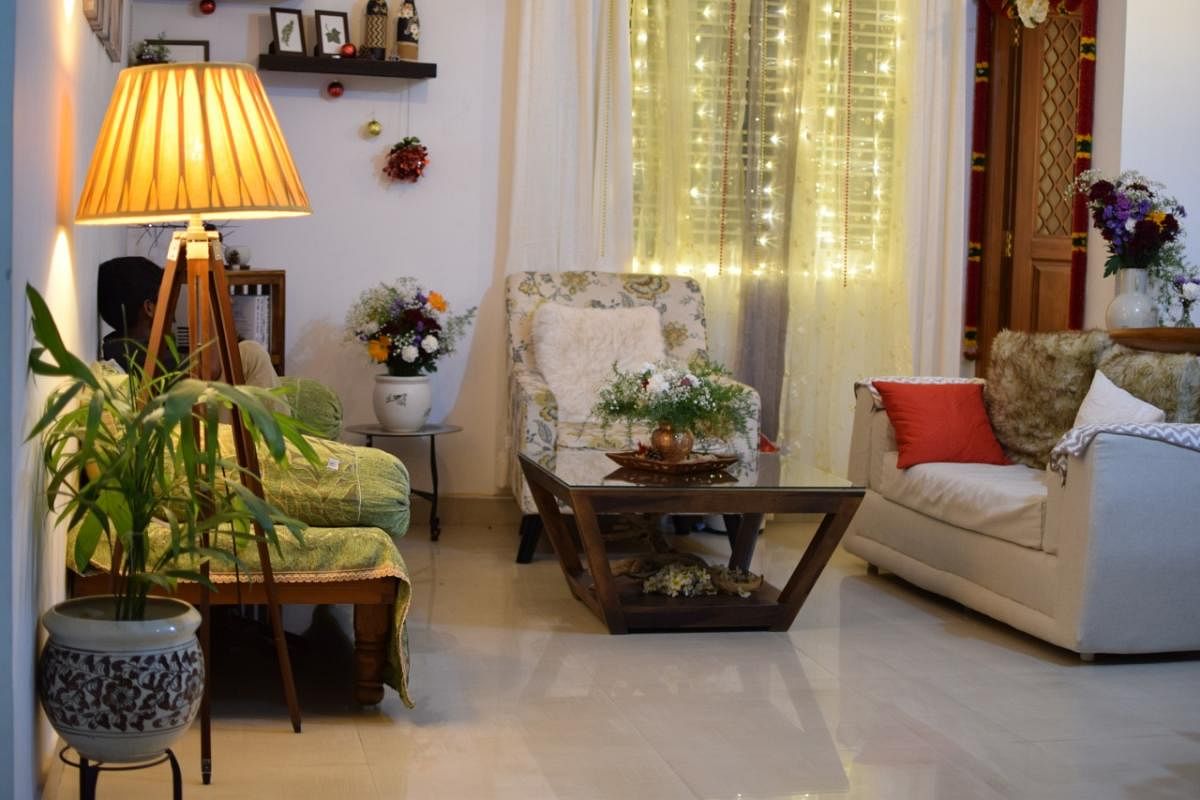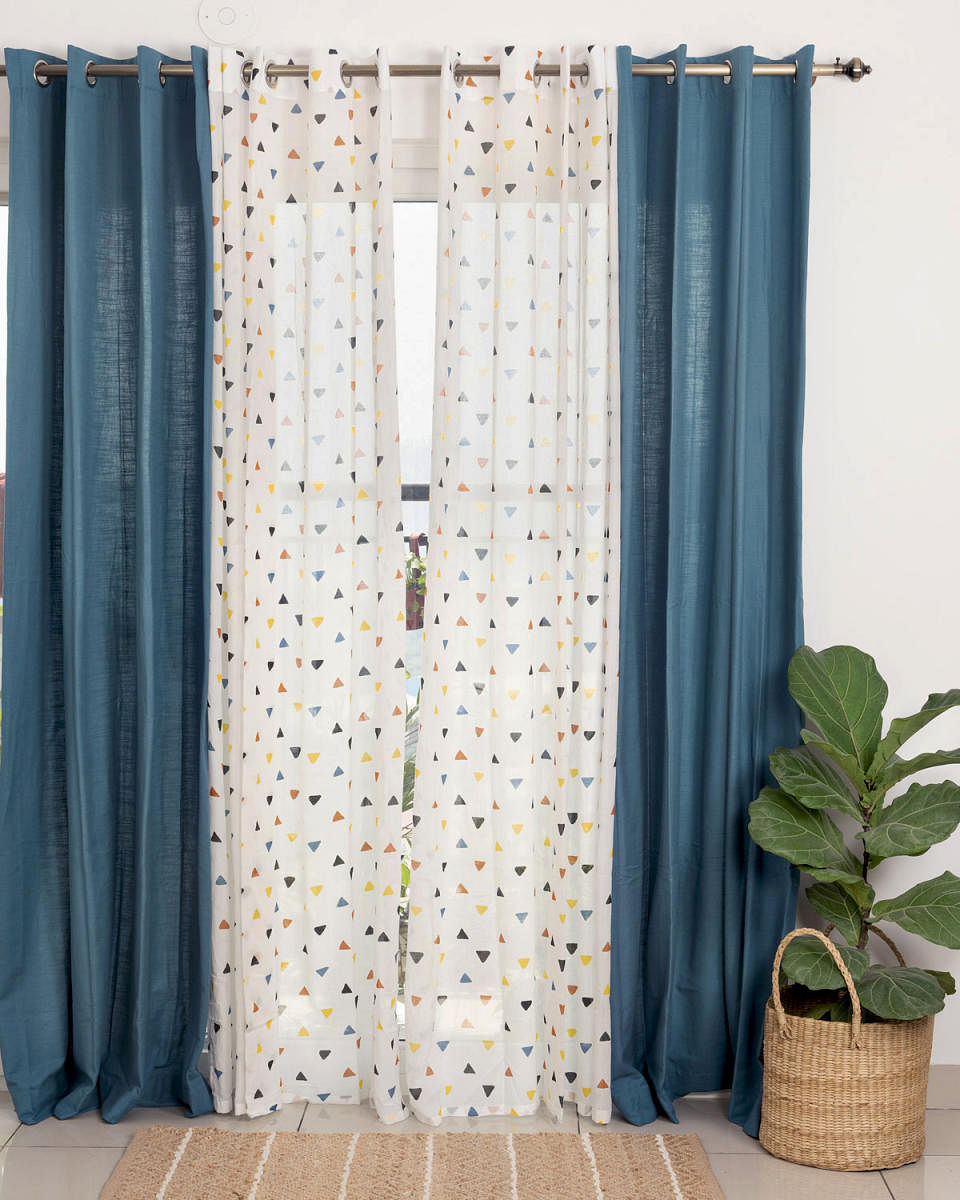

Manjulika Pramod, a Delhi-based travel writer and blogger, found herself confined, away from home, when travel restrictions were imposed due to the pandemic. She recalls, “I was locked down, in a hotel room. Spending so much time indoors in a strange place, made me look at every corner of the space I occupied and introspect on how open, bigger and brighter spaces made me feel happier and fulfilled.” Upon her return, she realised ‘home’ became more important than ever. “I decluttered my space, upcycled my old furniture, recycled waste into art projects, changed, carved a space for my own little nursery to strengthen my connection with nature. My home now looks more vibrant and livelier.”
Homebound life became a universal experience in 2020. Besides a range of economic, social, and cultural impacts that living inside our bubbles has brought out, there is a significant material aspect that has often been ignored. Of course, there are those new ‘work from home’ pajamas, house-slippers and hoodies. However, it doesn’t stop there. We have an expanding inventory of moveable backrests that have worn down from us cradling our bodies all day long. Scroll through Instagram, and you will find reels featuring spaces refreshed with remote office partitions, standing desks, aquascapes, hydroponic gardening pods...you name it!
Notable among many proud organising moments, worktop lights and DIY craft, people seemingly have picked up interest in redesigning their living spaces, becoming intimately familiar with nooks and corners of their homes. A Bangalore-based IT professional, Sindhu Murthy, quips, “I cannot stay indoors for long. If I do, I get restless and unproductive. So, I thought of bringing the outdoors inside. I set up an aquascape. I started with a small fish tank and then scaled it up, to a bigger one, allowing me to grow aqua plants. I also added a floral subscription. That’s how I connected to nature and remained grounded.”
In other words, our homes turned into safety nests, which people relied on to experience moments of joy during a challenging time. Our “built-in spaces” are in spotlight, once again, as we stare at an epidemic of psychological fallout from the seemingly never-ending lockdowns and social isolation. Urban architects, designers and mental health experts are now pushing to attention, this deep connection between neuroscience, design and our emotional wellbeing. The duress of the pandemic has laid the ground for the next big debate: Could designing sustainable, better, and healthy living spaces be at the forefront of the public health battle?
Architecture and evolution
Discussions connecting the impact of the quality of our physical environments on our wellbeing is not new. The concept of architecture, as much more than just something that binds us ‘inside’ and protects us from the harshness of nature, into an encapsulation of manifold intangible and experiential cultural elements, has existed across civilisations of all times and ages. To understand the evolution of architecture, one can begin with the study of Geometry. Since earliest times, builders and architects have relied on imitating natural forms like the circular Stonehenge in Britain; and then applied mathematical principles to standardise, replicate and secure the structures. The ancient Roman architect, Marcus Vitruvius, is credited with penning down specific rules in his writings, De Architectura. Vitruvius, it is believed, is responsible for all the geometry in today’s built environment — at least, he was the first to write down the proportions for how structures should be constructed.
“If we are to look at it from an Indian perspective, what we call ‘geometry’ today, can be traced back to pre-Vedic times, which originated as a part of making mandalas and ritual spaces. In Vedic times, Sulba-Sutras that contain some of the earliest instructions on geometric design of sacred ritualistic structures and spaces, facilitated deepening of our understanding about the human evolutionary need of creating mind-spaces that delineates and manifests into a physical structure. Our brain is wired to anticipate and see geometrical patterns and it’s a universal language, which everyone understands across geographies and cultures, explains Sangeeth Pillai, Assistant Professor, Department of Architecture & Planning, Malaviya National Institute of Technology, Jaipur. “We, as humans, are endowed to experience and perceive the world primarily through our five senses, but aspire to expand beyond our limits. For us, space is a primary situating frame of reference, for all sorts of sensory input. This also means, we are constantly being reshaped and remodelled by our physical reality, by the configuration of spaces we inhabit, coexist and thrive,” he further notes.
To curve or not to curve
In a study in 2011, researchers conducted an evidence-based study to examine how furniture forms impact our emotional responses, shaping our knowledge of how the insides of the buildings influence the inside of our mind. The study found that furniture defined by straight edges was rated as far less appealing and approachable. It also concluded that rooms with lofty ceilings lead people to engage in more abstract styles of thinking. Prateek Rather, CEO and founder of an interior designing service provider explains, “Jagged edges and sharp points are design features that, if overused, can cause anxiety. A typical living room, for instance, often includes a statement piece like a coffee table with jagged or sharp edges. A table with rounded edges, on the other hand, allows our nervous system to relax.” He also noted that intentional empty spaces in our homes could help in creating little bubbles of openness, helping people feel less anxious.
Finding meaning in colour
The psychology of colour is another important factor in architecture and interior design. Colour can evoke and promote emotions; thus, influencing one’s mental wellbeing, especially during the kind of health crisis we are presently in. A study by the University of British Columbia involving 600 people performing a variety of basic cognitive tests displayed against red-, blue- or neutral-coloured backgrounds, supports this claim. Researchers found that people exposed against red colour, often associated with ‘danger’, were much better at skills that required accuracy and attention to detail, such as catching spelling mistakes or keeping random numbers in short-term memory. People exposed to blue, on the other hand, performed worse on short-term memory tasks, but did far better on those requiring some imagination, such as coming up with creative uses for a brick or designing a children’s toy out of simple geometric shapes. They automatically generated twice as many ‘creative inputs’ as it triggered associations with the sky and ocean, bringing to mind expansive horizons and diffused light. The mental association of the colour, with elements of danger or an expansive world, held the key to their imaginative power.
Abhinayah Sundaramoorthy, co-founder of a contemporary home furnishing store, agrees: “We have noticed an increase in demand for yellow, be it as a solid colour or a pattern. Our yellow, black, white, and grey cushions have done well in the past year. We believe it is the need for a little sunshine, cheer and happiness that draws people towards these colours. Neutral colours like grey and beige tend to balance out the space and give a soothing and grounding effect. Aquas and blues, on the other hand, give a calming and cool vibe to the space.”
Prakriti Poddar, a mental health expert, shares: “Artificially designed environments impact our mental health, because everything we see, observe and feel through our senses impacts us. When we look at environments that are stark, with no warmth in it, we begin to feel lonely or depressed. If there are snug elements such as cushions, rug, may be a throw, depending on which part of the world you are in, we end up feeling warm and nurtured.”
Tidy home, happy mind?
Although we have known for many years that feeling emotionally and physically good in a certain place is closely related to aesthetics, it is only in recent years that we have fully begun to grasp how our physical environments influence our cognition and brain processes. Clutter, for example, has been linked to poor sleeping and eating habits. In 2011, researchers using FMRI (Functional Magnetic Resonance Imaging) and other physiological measurements, found decluttering from the home and work environment resulted in a better ability to focus and process information, as well as increased productivity. Rohini Rajagopalan, a professional organiser and founder of an organising and decluttering service, believes that, “Our brains like order, and constant visual reminders of disorganisation drain our cognitive resources. Tidy spaces, thus, not only reduce the time we spend in cleaning spaces, but also allow us more time to spend with people we love and do things we have always wanted to, but never found the time for.”
Human-centric approach
The pandemic has resulted in economic hardships, pushing multiple generations of a family to live together, where they may continue to work, while their children attend online school remotely — from the living room, bedrooms, or at times, from the dining space. Our homes, which now represent several elements crucial to each generation, impacting our collective mental health, are giving rise to often stressful and sometimes comical situations. (The Texan lawyer, whose mishap with a cat filter on Zoom, left by his kid, turned him into a viral sensation overnight!)
The lack of clear distinction between work and leisure opportunities during the pandemic, may be interfering with our sense of routine and agency. “Our freedom to find and create organic interactions outside of the digital realm has been curtailed. Our ability to change environments and physically be in new places has been stunted, impacting our feelings of safety, and belonging, especially in vulnerable groups such as migrants, younger and older people. For many working women and families with children, dense and disruptive at-home conditions during the pandemic have led to a negative influence on productivity, social cohesion, and overall wellbeing,” argues Yuelin Ge, Research Associate, Centre for Urban Design and Mental Health.
Using what she calls the ‘GAPS’ framework, which entails ‘green, active, pro social and safe spaces’, Ge suggests incorporating elements into our environments that make us feel safe and secure. “Propagate plants, take daily walks outside even if it is around the block. Work out with friends, family members or partners. Set some time with friends or family in digital safe spaces for interactions that promote a sense of community, integration and belonging. Write in your journal or password-protected journaling apps to implement a sense of safety and security within yourself. If your physical environment is detrimental or unsafe, consider local support services or affordable teletherapy based on your situation.”
Dr Sruthi Atmakur-Javdekar, Director of GRIT Studio (environmental design and research) and a Research Associate at Children’s Environments Research Group (CERG), feels healthy and positive living spaces are built on the pillars of inclusion, diversity, and a multi-inter generational user perspective, “Of-course, clean, green, noise-proof, well-lit, ventilated places with natural light, are essential to living. But to truly enhance human wellbeing, we need to move beyond optimising single parameters and adopt a more holistic approach that takes its roots in social equity and justice. “After all, built-in environments are not mere physical spaces, but opportunities that provide for social interactions and decision making,” she concludes.
The author is a fellow at the Schizophrenia Research Foundation, India.